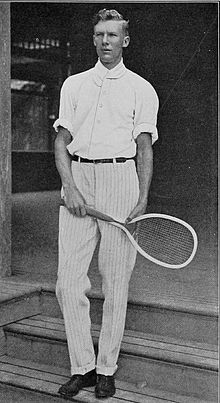Malcolm D. Whitman
 |
|
| Full name | Malcolm Douglass Whitman |
|---|---|
| Country (sports) |
|
| Born |
March 15, 1877 New York, NY, United States |
| Died | December 28, 1932 (aged 55) New York, NY, United States |
| Height | 1.87 m (6 ft 2 in) |
| Turned pro | 1896 (amateur tour) |
| Retired | 1917 |
| Plays | Right-handed (1-handed backhand) |
| Int. Tennis HoF | 1955 (member page) |
| Singles | |
| Career record | 110/28, (79.7%) |
| Career titles | 17 |
| Grand Slam Singles results | |
| US Open | W (1898, 1899, 1900) |
| Team competitions | |
| Davis Cup | W (1900, 1902) |
Malcolm "Mal" Douglass Whitman (March 15, 1877 – December 28, 1932) was an American tennis player who won three singles titles at the U.S. National Championships.
He graduated from The Roxbury Latin School, where he is celebrated as one of its greatest athletes. Whitman was American intercollegiate singles tennis champion in 1896 and doubles champion in 1897 and 1898 as a student at Harvard University. He graduated from Harvard Law School in 1899 and received his bachelor in law degree in 1902.
In 1896 Whitman entered his first U.S. National Championships at the Newport Casino and lost in the quarterfinals to Bill Larned. The following year, 1897, he again lost in the quarterfinals, this time against Harold Nisbet. Whitman is best known for this hat-trick of singles titles at the U.S. National Championships. Between 1898 and 1900, he stayed undefeated there. In 1901 he did not compete and in the 1902 Championships he lost in the All-Comers final to Englishman Reginald Doherty. According to the Doherty brothers Malcolm Whitman and Bill Larned were at the time the best American singles players.
He played on the inaugural American Davis Cup squad in 1900 and beat Englishman Arthur Gore in Boston, MA to help his US team win the trophy. In the 1902 Davis Cup final against Great Britain in Brooklyn, NY he again contributed to his team's win by defeating Joshua Pim and Reginald Doherty in the singles.
Whitman retired from tennis in 1902 at the age of 25. He was a member of the Executive Committee of the U.S. National Lawn Tennis Association (USNLTA) and held management positions in several companies.
In 1932 he wrote a book on the origin of tennis titled "Tennis - Origins and Mysteries".
...
Wikipedia
